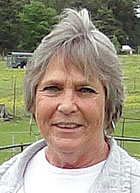 Jane and Tom Robinett own a goat dairy and dairy goat breeder operation on 10 acres outside of Dover, Ark.
Jane and Tom Robinett own a goat dairy and dairy goat breeder operation on 10 acres outside of Dover, Ark.
The idea began in California when Jane decided to buy three dairy goats as mowers for their acreage and to provide milk. Laughing at the memory, Jane said, “I will never forget the first time we tasted the milk. We held our noses and took an experimental sip. We were shocked that it tasted like cow milk but with a much less phlegmy texture.”
Years and several California moves later, the Robinetts came to Pope County, Ark., with 40 goats after the building containing their engine repair business had been sold. Because Tom wanted to be near family and where he grew up when he retired, they simply moved earlier than planned. Tom is now retired while Jane works as an accountant for Tax Centers of America.
Jane milks twice a day by hand rather than using her milking machines, which were essential temporarily due to a carpal tunnel issue.
“Actually, using the machines does not save time because I have to wait for my girls to finish eating and they’re slow. Besides, I find hand milking quiet and relaxing since I love being around my goats,” she said.
During peak season, her 23 milking does, out of a herd of 63, produced 10 to 20 gallons per day. Jane admits she could push for higher production, but doesn’t in order to help prevent milk fever and other issues.
Milk is sold only by preorder at least 24 hours in advance. Extra milk is processed into soft goat cheese of various flavors for self-consumption because cheese-making requires a license while 500 gallons of fresh milk can be sold without one.
Kids are removed from their mothers immediately after birth and are fed pasteurized goat milk by bottle for three days and by lamb bar, a bucket with nipples and straws reaching to the bottom, for three months when they are then weaned.
The Robinett goats are bred both naturally and through AI, which Jane learned in classes.
“I had one especially good teacher who taught me to determine the optimum insemination time by the texture of the does’ mucus when they become excited by the proximity of bucks,” she explained. “This is really important because goat semen has a short lived viability window, especially compared to cows. Since that class, my conception rate has been very high.”
Jane used to collect semen from her bucks, but quit once her freezer filled with semen from highly desirable bloodlines, including the Kastdemur line.
The Robinetts use two avenues for herd improvement. They occasionally buy does and have six from the Kastdemur line. They also select semen for does according to the trait or traits they want to be used with a particular doe. The dual breeding process is especially important since Jane loves to show her goats. She is competitive and always striving to be the best.
“Karen Senn’s Kastdemur line goats were the ones I could never quite beat,” Jane said.
Health protocols for the Robinett dairy include vaccinating for an over eating disease called intertoxemia, combined with a tetanus component and the debudding of would-be horns. Pasteurized goat milk for the babies prevents arthritis. Baby goats are treated every three weeks for cocci prevention and wormed with a liquid for the first four months. Goats receive one pour on wormer administered orally and another poured on to combat the eternal worm problem in three applications 10 days apart. Additional worming is on an as needed basis determined by frequently checking for a healthy pink inner eyelid color.
The feeding regimen includes both Bermuda and alfalfa hay, a 14 percent pellet grain feed, minerals and, surprisingly, baking soda purchased in 25-pound bags to prevent bloating. The goats graze on pastures providing fertilization and weed control.
“My goats love their weeds and do just fine without brush,” Jane said.
The Robinetts sell their goats as young as 2 weeks old. Jane once sold a 10-year-old doe to a neighbor who uses the milk to make and sell soap and other goat milk products such as lotion. Jane sells to other dairy goat farmers, to youngsters in FFA or 4-H and to anyone else interested. Jane preselects replacements and sells any left to maintain her herd size.
A final income stream is Jane’s side career as a nationwide dairy goat judge. When she judges, all expenses are paid in addition to a per diem. Because she so enjoys the show goat circuit, she is hoping to one day decrease her herd size and travel with her goats in her horse trailer with a living compartment to compete much more frequently and not have as many goats left behind at home for care by someone else.







